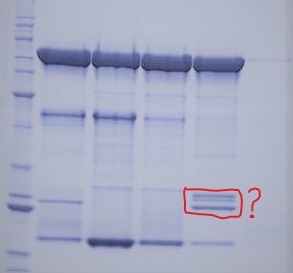We offer:
- Proteins extraction and identification from gels.
- Protein and peptide identification from solution. e.g. confirmation of a purified protein, identifying protein interactors from a pull-down experiment, or identifying hundreds proteins present in cell line/tissue (refer to Quantitative Proteomics section).
- Peptide sequencing using a variety of MS/MS fragmentation techniques.
Background Information
To identify proteins by mass spectrometry, the protein of interest (either excised from gel or present in solution) is reduced and then digested into peptides using trypsin. The peptides are then separated by liquid chromatography which is coupled to the mass spectrometer. In the mass spectrometer, the peptides’ masses are determined and through MS/MS we can confirm their sequence. Any peptide sequences detected are then matched against a protein database to confirm which protein they derive from and thus which proteins were originally present in the sample. Typically >2 unique peptides need to be detected from the same protein to verify its presence. Relative protein quantitation can be inferred by measuring their resulting peptides’ abundances in the mass spectrometer.
 Gel bands can be cut and provided to us
Gel bands can be cut and provided to us
for protein/peptide identification
For protein/peptide identification, we utilise the Orbitrap Elite and Q-Exactive HF mass spectrometers. Both instruments are equipped with a nano-flow LC system with reverse phase column.
How to prepare samples for analysis
For gel samples:
- Wash the gel thoroughly in water, making sure to use gloves throughout to avoid keratin contamination. Use a clean container that has not previously been used for Western Blot analysis.
- Place the gel on a clean glass slide under a flow hood.
- Cut as close as possible around the band of interest and place in an eppendorf. Alternatively, if no flow hood is available, please provide the whole gel and an annotated picture detailing which bands are to be analysed.
- Submit the sample along with a picture of the gel and information on the type of stain used so we can estimate the sample concentration ready for analysis.
For pull-down experiments:
We require 10 µg of protein to perform the digestion and analysis steps. We can perform the digestion either on the eluted protein sample or whilst attached to beads. In all cases, please provide information as to the bait protein/antibody being used.
Note: for all pull down experiments a minimum of two samples are required: your sample and a negative control. This allows us to distinguish protein interactors from any contaminant proteins present.
For in-solution samples:
We require a minimum of 10 µg of protein. Please provide details of the buffer composition that the sample is provided in.
Note: PEG, glycerol and detergent are not amenable to mass spectrometry analysis and must be removed prior to sample submission. Analysis on lower sample volumes/concentrations can be attempted but results are not guaranteed. Alternative proteases can be used upon request.
Sample Submission
To download the sample submission form click here.
Note: sample submission signifies agreement with our terms and Conditions of Service.
Please contact us if you have any questions or queries.